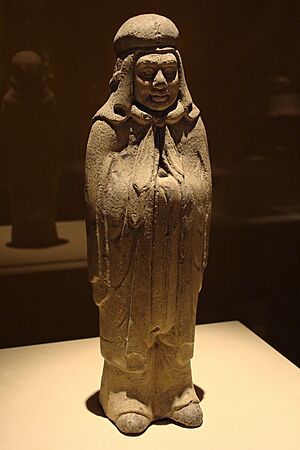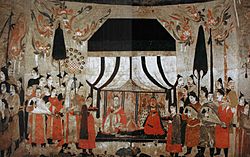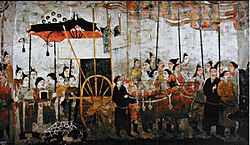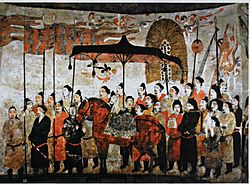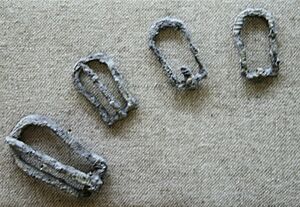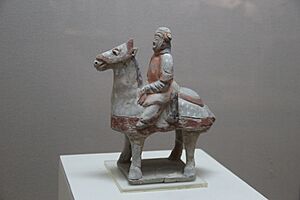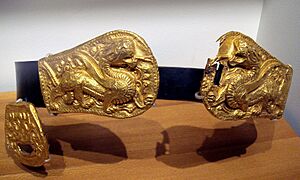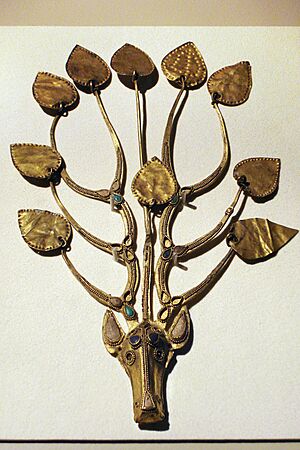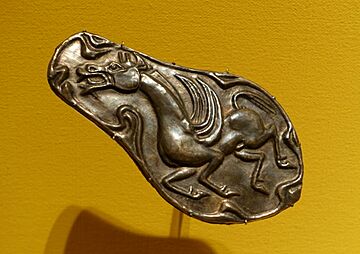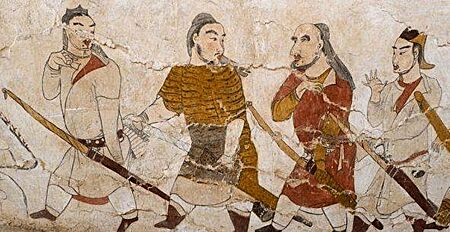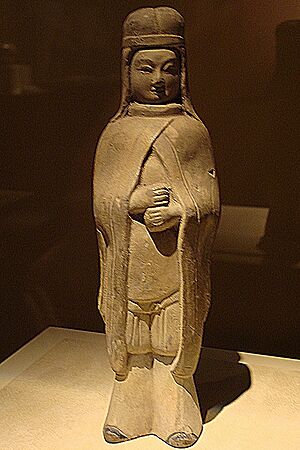Xianbei facts for kids
Quick facts for kids
Xianbei
鮮卑
Xiānbēi |
|||||||||||||
|---|---|---|---|---|---|---|---|---|---|---|---|---|---|
| 3rd century BC–3rd century AD | |||||||||||||
| Status | Nomadic empire | ||||||||||||
| Capital | Mount Danhan (near Shangdu County, Inner Mongolia) | ||||||||||||
| Common languages | Xianbei | ||||||||||||
| Religion | Shamanism Tengrism Buddhism |
||||||||||||
| Government | Tribal confederation | ||||||||||||
| Chieftain | |||||||||||||
|
• c. 156–181
|
Tanshihuai | ||||||||||||
|
• c. 181–189
|
Helian | ||||||||||||
|
• c. 190s
|
Kuitou | ||||||||||||
| Historical era | Antiquity | ||||||||||||
|
• Established
|
3rd century BC | ||||||||||||
|
• Disestablished
|
3rd century AD | ||||||||||||
| Area | |||||||||||||
| 200 | 4,500,000 km2 (1,700,000 sq mi) | ||||||||||||
|
|||||||||||||
| Xianbei | |||||||||||||||||||||||||||||
|---|---|---|---|---|---|---|---|---|---|---|---|---|---|---|---|---|---|---|---|---|---|---|---|---|---|---|---|---|---|
| Traditional Chinese | 鮮卑 | ||||||||||||||||||||||||||||
| Simplified Chinese | 鲜卑 | ||||||||||||||||||||||||||||
|
|||||||||||||||||||||||||||||
The Xianbei (pronounced shyen-BAY) were an ancient group of nomadic people. They lived in the eastern Eurasian steppes, which is a large grassland area. Today, this area includes parts of Mongolia, Inner Mongolia, and Northeastern China. The Xianbei were a mix of different groups, mainly Mongolic speakers. Some also spoke Tungusic and Turkic languages.
The Xianbei came from the Donghu people. The Donghu split into the Wuhuan and Xianbei after being defeated by the Xiongnu around 208 BC. For a while, the Xianbei lived north of the Wuhuan and didn't directly interact with the Han Dynasty. But in the 1st century BC, they started getting involved in fights between the Han and Xiongnu. By 93 AD, the Xianbei had become strong enough to take over the Mongolian Plateau from the Xiongnu.
In the mid-2nd century, a powerful leader named Tanshihuai united the Xianbei tribes. He led them in wars against the Han dynasty. His group was a big threat to the Han's northern borders for many years. However, after Tanshihuai died in 181 AD, his confederation quickly fell apart. Later, the Xianbei moved south and settled closer to the Han Chinese. They became allies or subjects of Chinese dynasties.
The Xianbei were one of the "Five Barbarians" who settled in northern China. They fought alongside the Western Jin dynasty during some major wars. Eventually, they became independent as the Jin dynasty moved south. During the Sixteen Kingdoms period, the Xianbei created several short-lived states in northern China. They even established themselves in the Central Plains, a very important area.
At one point, the Xianbei were ruled by the Former Qin dynasty. But the Former Qin fell apart after losing the Battle of Fei River. After this, the Tuoba Xianbei formed the Northern Wei dynasty. They eventually reunited northern China, starting the Northern and Southern dynasties period. The Northern Dynasties were led or strongly influenced by the Xianbei. They sometimes tried to keep their own culture, but often adopted Chinese ways. By the Tang dynasty, they had largely blended with the Chinese population. The Northern Wei also arranged marriages between their royal family and important Han Chinese families.
Contents
What Does "Xianbei" Mean?
Historians have different ideas about where the name "Xianbei" comes from. One idea is that it might be linked to a Mongolic word meaning "crest" or "bristle." This could refer to the Xianbei's horses.
Another idea is that "Xianbei" was originally the name of a place. It might have referred to the Great Xianbei mountains. These mountains are now known as the Greater Khingan range in China.
Xianbei History: A Timeline
Early Beginnings and Conflicts
Ancient Chinese writings mention the Xianbei very early on. Around 208 BC, the Donghu people were defeated by the Xiongnu. This defeat caused the Donghu to split into two groups: the Xianbei and the Wuhuan. The Xianbei's language and culture were similar to the Wuhuan.
The Xianbei first had important contact with the Han dynasty around 41 and 45 AD. They joined the Wuhuan and Xiongnu in attacking Han lands. In 49 AD, a Han governor convinced a Xianbei leader named Pianhe to fight the Xiongnu. The Xianbei were rewarded for each Xiongnu head they brought.
In 85 AD, the Xianbei formed an alliance with the Dingling and Southern Xiongnu. Two years later, in 87 AD, the Xianbei attacked and killed the Xiongnu leader Youliu. By 93 AD, the Northern Xiongnu were pushed northwest by the Han dynasty. The Xianbei then took over the Mongolian Plateau. They absorbed about 100,000 Xiongnu tribes, which made them much stronger.
The Xianbei continued to raid Han territory. From 121 to 138 AD, the Xianbei under Qizhijian raided Han lands four times. Around 155 AD, the northern Xiongnu were completely defeated by the Xianbei.
The Xianbei Confederation Under Tanshihuai
Around the mid-2nd century, a powerful chieftain named Tanshihuai united all the Xianbei tribes. He set up his main court at Mount Danhan. This mountain is in what is now Shangdu County, Inner Mongolia. Under Tanshihuai, the Xianbei became very strong. They defeated the Wusun in the west and pushed back the Dingling from the north. They also repelled the Buyeo from the east. Their territory stretched from the Liao River to the Ili valley.
Tanshihuai divided his large empire into three parts: eastern, middle, and western. Each part was led by a chosen chieftain. Tanshihuai often attacked the northern borders of the Han dynasty. His first recorded raid was in 156 AD. In 166 AD, he even teamed up with the Southern Xiongnu and Wuhuan to attack Shaanxi and Gansu. These raids caused a lot of damage and loss of life. The Han dynasty tried to make peace by offering Tanshihuai the title of King. But he refused and kept attacking their borders.
In 177 AD, the Han sent a large army of 30,000 soldiers against the Xianbei. But the Xianbei defeated them, and only a tenth of the Han forces returned. A report from that year said the Xianbei had taken all the lands previously held by the Xiongnu. Their warriors numbered 100,000. Han deserters who joined the Xianbei helped them make better weapons. Their weapons were sharper and their horses faster than those of the Xiongnu. Another report in 185 AD stated that the Xianbei were raiding Han settlements almost every year.
Despite their constant raids, the Xianbei confederacy was not as organized as the Xiongnu empire. They struggled to support their growing population. Tanshihuai died in 181 AD. His son, Helian, took over, but he was not as skilled as his father. Helian was killed during a raid. Helian's son, Qianman, was too young to rule. So, the chieftains chose his cousin, Kuitou, as the new leader. When Qianman grew up, he challenged Kuitou for power. This fight destroyed the last bit of unity among the Xianbei.

Xianbei During the Three Kingdoms Period
By the early 3rd century AD, the Xianbei had split into many different groups. The most important leaders were Kuitou in Inner Mongolia, Kebineng in northern Shanxi, and Suli and Mijia in northern Liaodong. After Kuitou died, his brothers Budugen and Fuluohan became leaders. In 207 AD, after Cao Cao defeated the Wuhuan, Budugen, Fuluohan, and Kebineng all paid tribute to him.
In 218 AD, Fuluohan tried to form an alliance with a Wuhuan leader. But the Wuhuan leader tricked him and called in Kebineng, who killed Fuluohan. Budugen later sought help from the Cao Wei court against Kebineng. However, he eventually allied with Kebineng in 233 AD. Kebineng then killed Budugen shortly after.
Kebineng came from a smaller Xianbei tribe. He became powerful by taking in Chinese refugees. These refugees helped him train his soldiers and make weapons. He acknowledged Cao Pi as emperor of Cao Wei in 220 AD. But he later turned against Wei and raided their lands. Kebineng was killed in 235 AD, and his confederacy then broke apart.
Many Xianbei tribes moved south and settled near the Wei-Jin dynasties. They often submitted to Chinese rule. For example, the Tuoba tribe settled in Yanmen Commandery in 258 AD. Other tribes like the Yuwen, Murong, and Duan also settled in different parts of northern China. In the west, a group of Murong moved into Qinghai and mixed with the local Qiang people, becoming the Tuyuhun.
The Sixteen Kingdoms and Northern Wei Dynasty
During the War of the Eight Princes, the Xianbei from the northeast were brought in to fight in the civil wars of the Jin princes. They played a very important role in these wars. When the Xiongnu in Shanxi rebelled and started the Han-Zhao dynasty, the Tuoba Xianbei helped the Jin fight them. The Jin dynasty relied heavily on the Xianbei's military power as they lost control of the north.
For their help, the Duan and Tuoba tribes were given important territories. However, most Xianbei groups eventually left the conflict. This allowed the Jin dynasty to be quickly overwhelmed. Many Chinese officials, soldiers, and civilians fled south to join the Eastern Jin. Others went north to join the Xianbei groups.
The Xianbei founded several of the Sixteen Kingdoms in northern China. The Murong of Liaodong were the most famous clan during this time. They adopted the Jin governing system and customs. They became powerful during the fall of Western Jin by offering safety to Chinese exiles. They eventually established Xianbei rule over the Central Plains. They founded states like the Former Yan (337–370) and Later Yan (384–407). The Murong controlled the northeast and at one point wanted to unite all of China. But they failed due to family conflicts and weak rulers. Meanwhile, in Gansu, the Qifu established the Western Qin (385–431).
The Tuoba kept their territory of Dai (310–376). It became a kingdom in 315 AD. But they were later conquered by the Former Qin dynasty. With the fall of Dai, northern China was briefly united under the Qin. However, the Qin quickly collapsed after a huge defeat at the Battle of Fei River in 383 AD. After this, the Tuoba brought back their state as the Northern Wei dynasty (386–535). This marked the beginning of the Northern Dynasties (386–581). The Northern Wei grew stronger after defeating the Later Yan. In 439 AD, they conquered the last of the Sixteen Kingdoms. This united northern China and started the Northern and Southern dynasties period.
Blending Cultures: Sinicization and Assimilation
The Northern Wei's unification brought a period of peace to northern China after the chaotic Sixteen Kingdoms period. Emperor Xiaowen of Northern Wei started a policy of systematically adopting Chinese culture, called sinicization. His successors continued this, and Xianbei traditions were largely given up. The royal family went even further by changing their Xianbei names to Chinese names. They even changed their own family name from Tuoba to Yuan. Emperor Xiaowen also moved the capital to Luoyang, a very important Chinese city. This was far from their old capital near the northern borders. People in Luoyang were open to these changes. But those near the old capital were more traditional and kept their Xianbei culture.
Marriages with important Han Chinese families were encouraged. In the 480s, the Northern Wei arranged for Han Chinese elites to marry daughters of the Xianbei Tuoba royal family. More than half of the Tuoba Xianbei princesses of the Northern Wei married Han Chinese men. These men were from royal families and nobles from southern China who had joined the Northern Wei. Some Han Chinese royal families who were exiled from southern China also joined the Xianbei. Several daughters of Emperor Xiaowen of Northern Wei married Han Chinese elites.
In 534 AD, the Northern Wei split into the Eastern Wei (534–550) and Western Wei (535–556). This happened after several uprisings in six major frontier towns in the north. These towns were home to Xianbei, Han Chinese, and other groups. The usual reason given for these uprisings is the Northern Wei's sinicization policies. After the capital moved to Luoyang, the power of the Xianbei military leaders in the north decreased. This led to widespread unhappiness. However, some studies suggest the uprisings were more about corruption among the upper-class military leaders. They also point to a weak economy and harsh conditions in the frontier towns.
The Eastern Wei became the Northern Qi (550–577), and the Western Wei became the Northern Zhou (557–581). The Southern Dynasties were pushed south of the Yangtze River. The Northern Qi was ruled by the Gao clan, a Han Chinese family who had adopted Xianbei ways. They were supported by Xianbei elites and favored Xianbei traditions. The Northern Zhou was ruled by the Yuwen clan, who were Xianbei. They ruled over mostly Chinese people. The Northern Zhou tried to bring back the Xianbei warrior culture. This included changing back the sinicized names from the Northern Wei. They also gave Xianbei names to Han Chinese officers as a reward. However, the Prime Minister of Northern Zhou, Yang Jian, later changed these names back to Han names.
In 581 AD, Yang Jian founded the Sui dynasty (581–618). His son, the future Emperor Yang of Sui, conquered the Chen dynasty, the last kingdom of the Southern Dynasties. This united much of China. After the Sui dynasty ended due to rebellions, his cousin, Li Yuan, founded the Tang dynasty (618–907). The Sui and Tang dynasties were founded by Han generals who had also served the Northern Wei dynasty. Through these new governments, the Xianbei who had moved into China largely blended with the Chinese. For example, the wife of Emperor Gaozu of Tang, Duchess Dou, and Emperor Taizong of Tang's wife, Empress Zhangsun, both had Xianbei ancestors. Those Xianbei who stayed in the northern grasslands later became powerful groups like the Mongol Yuan dynasty and Manchu Qing dynasty.
In the west, the Xianbei kingdom of Tuyuhun stayed independent until it was defeated by the Tibetan Empire in 670 AD. After the kingdom fell, the Xianbei people spread out over a large area. This stretched from the northwest into central and eastern China. Murong Nuohebo led the Tuyuhun people eastward into central China. They settled in modern Yinchuan, Ningxia.
Xianbei Culture and Lifestyle
The Xianbei mainly raised animals, but they also practiced some farming. They were the first to develop the khanate system. This system led to deeper social classes. They also made progress in writing, arts, and culture. They used a zodiac calendar and enjoyed singing and music. Tengrism and later Buddhism were their main religions. After they moved from the cold north to Northern China, they slowly gave up their nomadic lifestyle. They became more like the Han Chinese and blended in. Emperor Xiaowen of Northern Wei even ordered that Xianbei names be changed to Chinese names.
Before Tanshihuai, the Xianbei did not have a system where leaders inherited their power. Instead, their chieftains were chosen by electing someone based on their character and skills. Even when they set up their states in China and adopted the Chinese system of inherited rule, the brothers and uncles of Xianbei rulers often tried to claim the throne for themselves.
Xianbei Art and Creativity

Xianbei art showed their nomadic way of life. It mostly included metalwork and small statues called figurines. Xianbei art was influenced by many different cultures. They were known for using unique nomadic designs in their art. These included leaf headdresses, images of crouching and geometric animals, animal necklaces, and metal openwork.
Leaf Headdresses
Leaf headdresses were a very special part of Xianbei culture. They are often found in the tombs of the Murong Xianbei. These gold hat ornaments looked like trees and antlers. In Chinese, they are called buyao, which means "step sway." This is because the thin metal leaves would move when the person wearing them moved. These headdresses were made from hammered gold. They were decorated by punching out designs and hanging the leaf pendants with wire. Similar headdresses were also worn by women in the courts later on.
Animal Art
Another important type of Xianbei art was animal images, mostly in metalwork. The Xianbei often showed animals crouching in geometric, repeated shapes. They also showed animals fighting each other. Sheep, deer, and horses were commonly shown. These art pieces, usually plaques or pendants, were made of metal. The backgrounds were often decorated with openwork or mountain scenes, which reflected their nomadic life. The image of the three deer plaque is a great example of Xianbei art. It shows repeated animal images, an openwork background, and a rectangular frame.
Horses in Art
The Xianbei's nomadic traditions inspired them to show horses in their artwork. Horses were very important to the Xianbei's way of life. In one tomb, a horse skull was found with Xianbei bells, buckles, ornaments, a saddle, and a gilded bronze stirrup. The Xianbei not only made art for their horses but also made art that showed horses. Another common image was the winged horse. Some archaeologists believe this symbol was a "heavenly beast in the shape of a horse." This is because it was important in Xianbei stories. This symbol is thought to have guided an early Xianbei migration south. It appears often in many Xianbei art forms.
Figurines and Daily Life
Xianbei figurines (small statues) help us understand the people of their society. They show their hobbies, special clothing, and beliefs. Most figurines have been found in Xianbei tombs. They are usually military figures and musicians. These were meant to serve the deceased in the afterlife and guard their tomb. The clothing on the figurines also showed social status. Higher-ranking Xianbei wore long-sleeved robes. Lower-ranking Xianbei wore trousers and belted tunics.
Buddhist Influences in Art
Xianbei art also shows influences from Buddhism. This came from their interactions with Han Chinese culture. At first, Han officials helped the Xianbei run their state. But eventually, the Xianbei became interested in Chinese culture and promoted Buddhism. The start of this change is seen in Buddha images appearing in Xianbei art. For example, a leaf headdress with a Buddha image perfectly shows how traditional Xianbei art combined with new Buddhist ideas. This religious change continued in the Northern Wei dynasty. It eventually led to the creation of the famous Yungang Grottoes, which are large cave temples with Buddha statues.
Xianbei Language
| Xianbei | |
|---|---|
| Serbi | |
| Native to | Xianbei state |
| Region | Mongolian–Manchurian grassland |
| Ethnicity | Xianbei |
| Era | c. 3rd century BC – c. 3rd century AD |
| Language family |
Serbi–Mongolic?
|
Experts believe the Xianbei spoke Mongolic or related languages. They also had early and strong influences from Turkic languages. Some scholars thought the Xianbei were Turks. This would mean that early Turkic words borrowed into Mongolic came from the Xianbei. However, it is now more likely that the Xianbei were Mongolic or Para-Mongolic speakers. This suggests that some Mongolic words were borrowed into Turkic languages during the Xianbei period.
It's also possible that the Xianbei spoke more than one language, as they were a mix of different groups.
Who Were the Xianbei? (Anthropology and Genetics)
Some historians think the Xianbei might have had "exotic" features. These could include high nose bridges, blond hair, and thick beards. However, other scholars suggest the Xianbei looked similar to modern East Asians. A genetic study of Emperor Wu of Northern Zhou showed he had an East Asian appearance. This supports the idea that most Xianbei looked like East Asians.
When Chinese sources mention "yellow hair," it might have meant brown hair, not blonde. It could also have described other groups, not just the Xianbei. Chinese anthropologists have studied Xianbei skulls. They found that the Xianbei's physical features are closely related to modern East Asians. Some features are even closer to modern Mongols, Manchu, and Han Chinese.
Genetic Studies of the Xianbei
Genetic studies have helped us learn more about the Xianbei.
- A 2006 study looked at the DNA of 21 Tuoba Xianbei. Their DNA belonged to haplogroups (genetic groups) common in Northeast Asia. They were most closely related to the Oroqen people today.
- A 2014 study of 17 Tuoba Xianbei also found haplogroups common in East Asia.
- A 2007 study of 17 Murong Xianbei found different haplogroups. These were common among East Asians and some Siberians. The Murong Xianbei's maternal DNA was different from the Huns and Tuoba Xianbei.
- A 2018 study found a specific paternal haplogroup (C2b1a1b) in both Xianbei and Rouran people. This suggests it was an important lineage among the Donghu people.
- A 2023 study looked at the full DNA of nine Xianbei individuals. It found that the Xianbei were a very similar group of people. They mostly had ancestry from Ancient Northeast Asians. This supports the idea that their ancestors came from the Amur River region, near the Greater Khingan mountains. Early Xianbei did not show much mixing with other groups. Later Xianbei showed some mixing with "late Xiongnu-like" and Han Chinese groups. Later Xianbei in Northern China adopted farming. They mixed with the local population, adding to the genetic history of Northern China.
- A 2024 study on Xianbei remains, including Emperor Wu of Northern Zhou, found they were mostly from Ancient Northeast Asians (62–96%). They had less mixing from Neolithic 'Yellow River farmers' (Han Chinese). Very little or no Western Steppe Herder ancestry was found. The Xianbei remains are most genetically similar to ancient Khitan and Mohe people, and modern Mongolic peoples. The amount of Ancient Northeast Asian and Yellow River farmer ancestry varied by location. This suggests there were some differences among the ancient Xianbei. In contrast, the early Turkic ruling class (Ashina tribe) was almost entirely from Ancient Northeast Asians, with no significant Yellow River ancestry.
Famous Xianbei People
Here are some notable individuals from Xianbei history:
Early Leaders
- Tanshihuai (136–181): A powerful Xianbei leader who united the tribes.
- Kebineng (died 235): A Xianbei chieftain during the late Han dynasty and Three Kingdoms period.
- Tufa Shujineng (died 279): A Xianbei chieftain during the Three Kingdoms period.
Leaders During the Sixteen Kingdoms
- Murong Hui (269–333): Chieftain of the Murong tribe.
- Murong Tuyuhun (246–317): Founder of the Tuyuhun kingdom.
- Murong Huang (297–348): Founder of the Former Yan state.
- Murong Chui (326–396): A general and founder of the Later Yan state.
- Murong Ke (died 367): A general and statesman of the Former Yan.
- Murong Chong (359–386): Second ruler of the Western Yan.
- Murong De (336–405): Founder of the Southern Yan state.
- Tuoba Yilu (died 316): Founder of the Tuoba Dai state.
- Tuoba Shiyijian (320–376): Last ruler of the Tuoba Dai.
- Tufa Wugu (died 399): Founder of the Southern Liang state.
- Tufa Rutan (365–415): Last ruler of the Southern Liang.
- Qifu Gangui (died 412): Second ruler of the Western Qin state.
- Qifu Chipan (died 428): Third ruler of the Western Qin.
Northern Dynasties Figures
- Tuoba Gui (371–409): Founding emperor of the Northern Wei dynasty.
- Tuoba Tao (408–452): Third emperor of the Northern Wei.
- Yuwen Tai (507–556): A powerful general of the Western Wei state.
- Dugu Xin (503–557): A powerful general of the Western Wei state.
- Lou Zhaojun (501–562): An empress dowager of the Northern Qi state.
- Yuwen Hu (513–572): A regent (someone who rules for a young king) of the Northern Zhou state.
- Yuwen Yong (543–578): Emperor of the Northern Zhou state.
Sui Dynasty Figures
- Dugu Qieluo (544–602): Empress of the Sui dynasty.
- Yuwen Shu (died 616): A powerful general of the Sui dynasty.
- Yuwen Huaji (569–619): A powerful general of the Sui dynasty.
Tang Dynasty Figures
- Empress Zhangsun (601–636): Empress of the Tang dynasty and wife of Emperor Taizong.
- Zhangsun Wuji (died 659): A powerful official and chancellor in the early Tang dynasty.
- Yuchi Jingde (585–658): A famous general in the early Tang dynasty. He is worshipped as a door god in Chinese folk religion.
- Yuwen Shiji (died 642): An official and chancellor in the early Tang dynasty.
- Yuan Zhen (779–831): A poet and politician in the middle Tang dynasty.
Modern Descendants of the Xianbei
Most Xianbei clans adopted Chinese family names during the Northern Wei Dynasty. Many changed their names under Emperor Xiaowen of Northern Wei's policy of sinicization.
The Northern Wei had eight noble Xianbei surnames. These were Buliugu, Helai, Dugu, Helou, Huniu, Qiumu, Gexi, and Yuchi.
The "Monguor" (Tu) people in modern China might be descendants of the Xianbei. They were led by Tuyuhun Khan to move west and establish the Tuyuhun Kingdom (284–670). Today, they live mainly in Qinghai and Gansu Province and speak a Mongolic language.
The Xibe or "Xibo" people also believe they are descendants of the Xianbei.
Some Korean families today have surnames that may come from Xianbei ancestors. These include Mo (from Murong), Seok (from Wushilan), Won (from Tuoba), and Dokgo (from Dugu).


